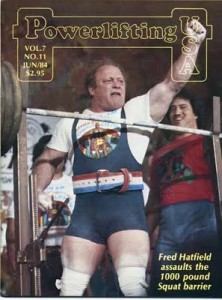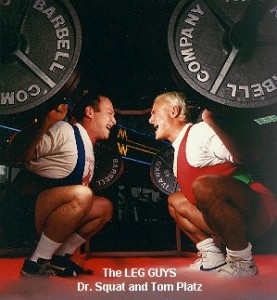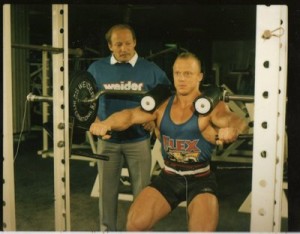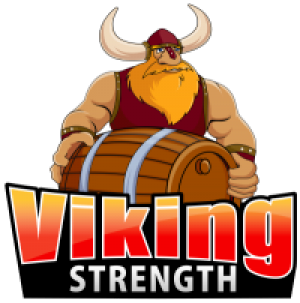I first came across the strength training articles of Fred Hatfield when I was a teenager reading through various Bodybuilding Magazines. His articles were always provacative and well written, with plenty of science to back up the content.

It has always been a personal ambition to interview Fred Hatfield for the Viking Supplements blog, and when Fred kindly agreed, it didn’t take me long to put together a few questions for him. Fred is a True Authority in strength sports, which can be clearly seen from his acheivements. To quote from his website www.drsquat.com:
The founding editor of Sports Fitness magazine (now Men’s Fitness), he has written more than 60 books and over 200 articles on sports fitness, weight training and athletic nutrition. He is a former standout college gymnast, Mr. Teenage Connecticut, Mr. Atlantic Coast and Mr. Mid America in bodybuilding, Wisconsin and Connecticut weightlifting champion, broken over 30 world records as a powerlifter competing in five different weight divisions, and won the World Championships in powerlifting three times in three different weight divisions. In 1987, at the age of 45, Hatfield established a world record in the squat at 1014 pounds (255 body weight), the most anyone had ever lifted in the history of competition.
So without any further introduction required lets get into the interview.
PB: In the sport of Powerlifting do you think todays Super-suits help too much? What are your feelings on these? Do you believe that they have made powerlifting farcical in the same way that the swimming suits have affected that sport, and the swimming course records which were smashed?
FH: Can we agree that powerlifting, as a legitimate sport, offers the athlete an opportunity to test his or her strength against that of other competitors? The ready reply is yes, this is the entire point of the sport. In today’s competitive setting, however, this is not being accomplished, and the result is that something other than “sport” is being engaged in. You can call it a farce or a circus side show if you like. I choose to call it a crying shame, and the athletes are being robbed of the opportunity to compete against the lifters of yesterday. I have written about this numerous times, so I won’t belabor the issue. At least the swimmers realized their mistake and banned the hydrodynamic suits. We ought to ban the supportive garb.
PB: In the realm of Strength Sports who was the athlete you respected the most and why? Who do you enjoy watching the most now?
FH: Show me a lifter who is breaking world records without using the supportive gear! THAT is the lifter who has my respect! I have gravitated away from powerlifting and moved toward strongman competition. On the other hand, deadlifting remains relatively pure, as supportive garb doesn’t really offer that much in the way of assistance in that lift. I love to watch Magnús Ver Magnússon lift. He is one strong dude!
PB: I know that you have strong beliefs in the Christian faith, how has this helped you in your strength endeavours?
FH: Sport is an endeavor of man. As such, it is a carnal undertaking. God is a spirit. Clearly, the two cannot mix any more than water and oil. That’s scriptural. I participated in sport largely for ego gratification. How can one reconcile that with living a Christ-oriented life? You cannot, and nor should you try. On the other hand, sport, as in all other man-conceived endeavors, offers us examples – types and shadows – that help us understand God’s will and His nature. I also believe that throughout my life, including all the things I have experienced and learned along the way, I was being prepared to (finally) understand His will for my life.
PB: There is the famous photo of you and Tom Platz squatting facing each other, how did that photo come about and did you ever train with him, and if so was he as philosophical in the gym as he was on the Pumping Iron video?
 FH: Tom and I worked for Vince McMahon, owner of the WWE. He had it in mind to create a bodybuilding version of entertainment similar to pro wrestling, and hired Tom and I to pull it off. He also hired a dozen of the best bodybuilders in the world as talent. As a marketing gimmick, Tom and I were obliged to go head to head in a “great squat-off” at the FIBO exhibition in Germany. I came out of retirement. We trained together for months, and it became clear to me that Tom actually believed he could beat me! Ugh! I had to get serious! But to answer your question, Tom has always been very introspective and calculating in everything he does, just as he was in his bodybuilding training. He was hard to beat, but I pulled it off. On the other hand, he beat me for reps with 500-plus pounds, performing 24 or so against my paltry 12!
FH: Tom and I worked for Vince McMahon, owner of the WWE. He had it in mind to create a bodybuilding version of entertainment similar to pro wrestling, and hired Tom and I to pull it off. He also hired a dozen of the best bodybuilders in the world as talent. As a marketing gimmick, Tom and I were obliged to go head to head in a “great squat-off” at the FIBO exhibition in Germany. I came out of retirement. We trained together for months, and it became clear to me that Tom actually believed he could beat me! Ugh! I had to get serious! But to answer your question, Tom has always been very introspective and calculating in everything he does, just as he was in his bodybuilding training. He was hard to beat, but I pulled it off. On the other hand, he beat me for reps with 500-plus pounds, performing 24 or so against my paltry 12!
PB: Which one of your sporting achievements are you the most proud of and why?
FH: This is a hard one to answer. I suppose I enjoyed gymnastics the most, and was proud of some of my wins. Nothing beat making goals as a soccer player in high school though! What a rush! In powerlifting, all of my world records were pretty unremarkable in that I knew beforehand how much I could lift, so the actual lifts were somewhat … ho-hum.
PB: How often should people Squat? Once a week, or more or less frequent?
FH: There are some well known rules governing training frequency, duration and intensity, and all three vary greatly between lifters. So, each lifter must apply these rules to find their own specific FID schedule. Of course, I speak of the “seven granddaddy laws” of training. Then there are a few additional rules relating to gear vs. no gear, closeness to competition, and the like. If you aren’t familiar with the granddaddy laws, shame on you! That means you haven’t been reading my articles and books! Go to www.drsquat.com and search them out in a few of the articles there.
PB: Many medical people have stated over time, that Squatting is bad for your knees, how would you respond to that?
FH: They can be damaging if done improperly, and they can be beneficial if done properly! What more can I say?
 PB: Do you believe Knee Wraps, are useful or not?
PB: Do you believe Knee Wraps, are useful or not?
FH: They’re useful in preventing injury during extreme lifting. They can be useful in increasing the amount you can squat with. They can be dangerous if relied upon during training, owing to the support they provide robbing your tissues of needed stress in order to adapt.
PB: Other than the squat what is your next favourite exercise and why?
FH: All exercises are merely tools. I’m not in love with any one more than others. The idea strikes me as silly! As to which provides overarching benefit, I’d have to say squats first, then explosive high pulls.
PB: Viking Supplements sponsors 2 strength athletes Moe Westmoreland and Leigh Keen, they are young and working hard to become the best they can be in the world of strongman and strongwoman. What would be your top 3 tips you would give them to build up their strength as quickly as possible?
FH: Many supplement companies and equipment companies sponsor athletes. I was sponsored by Weider for many years, and truly thank Joe for his undying belief in me. Tip number one is for the lifter being sponsored to show respect and loyalty to his or her sponsor! Tip number two is to learn the science of strength! Your own beliefs are irrelevant. Trust science! Tip number three is to acquire passion for what it is that you do, for passion breeds a healthy uneasiness in your endeavors which prompts you to ever seek better ways to train.
PB: Secondly Leigh has been asking what do you recommend as the best way to releive post training muscle soreness the next day?
FH: Careful supplementation,therapy and periodization takes care of this novice scourge every time.
PB: If you could invite any 5 people living or dead to come training with you in the gym for an ultra intense workout who would you choose and why ?
FH: Magnús Ver Magnússon, Bill Kazmaier, Doyle Kenady, Joe Bradley, Hideki Inaba. These guys BELIEVE(D) in what they did. They were members of a very high priesthood. This is the quality all lifters should use in selecting who to train with.
PB: Thanks for your time , it is greatly appreciated.
FH: Sure, no problems.
Read our other strongman/powerlifters interviews:
Todd Whiter one of the strongest powerlifters pound for pound
Gawain Johnstone one of the fastest rising powerlifters
US Father and Son Powerlifters
Moe Westmoreland – Strongman arrives from powerlifters past
Eben Le Roux – Australian Strongman champion
Mark Wells – Australian Strongman Competitor
Sue Metcalf – Australian Strongwoman International Competitor
Fred Hatfield – Icon to Powerlifters worldwide
Sigfus Fossdal – Our First Interview – Powerlifters powerlifter.
Sigfus Fossdal – A Year on with the 398lb Powerlifters powerlifter
My Interview with Geoff Capes – Worlds Strongest Man Winner 1983/1985

1 comment
Comments are closed.